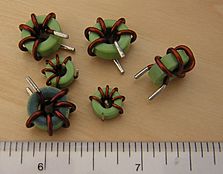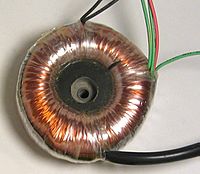Toroidal inductors and transformers facts for kids
Toroidal inductors and transformers are special electronic components. They look like a donut or a ring. Inside, they have a circular, ring-shaped magnetic core. This core helps electricity flow in a special way. One big advantage of these components is how they are made. Wires are wrapped around the ring in one continuous direction. This design helps prevent electrical interference between the wires, which can happen with other types of coils.
Contents
What Are Toroids and How Do They Work?
Toroids are electronic parts shaped like a donut. They are used in many devices, from radios to computers. The word "toroid" comes from the shape of a torus, which is like a bagel or a car tire.
Understanding Inductors and Transformers
An inductor is a coil of wire that stores energy in a magnetic field. Think of it like a tiny energy storage device for electricity. A transformer is a device that changes the voltage of an alternating current (AC). It can make voltage higher or lower. Both inductors and transformers use magnetic fields to work.
Why Toroidal Shapes Are Special
The ring shape of a toroidal core is very efficient. When wires are wrapped around it, the magnetic field stays mostly inside the core. This means less energy is lost to the surroundings. It also helps prevent the magnetic field from interfering with other nearby electronic parts. This makes toroidal components very useful in sensitive electronic circuits.
How Toroidal Inductors Work
A toroidal inductor is made by wrapping wire around a donut-shaped core. When electricity flows through the wire, it creates a magnetic field inside the core. This magnetic field stores energy. When the electricity changes, the magnetic field changes too. This change in the magnetic field tries to stop the change in electricity. This property is called inductance. Toroidal inductors are great because their magnetic fields are very contained. This means they are less likely to cause problems for other parts of a circuit.
How Toroidal Transformers Work
A toroidal transformer also uses a donut-shaped core. It has at least two coils of wire. One coil is called the primary coil, and the other is the secondary coil. When alternating current (AC) flows through the primary coil, it creates a changing magnetic field in the core. This changing magnetic field then creates electricity in the secondary coil. The number of turns in each coil determines if the voltage goes up or down. Toroidal transformers are often smaller and lighter than other types. They also make less noise and are more efficient.
Where Are Toroids Used?
Toroidal inductors and transformers are found in many places. You might not see them, but they are working hard inside your electronics.
Common Uses of Toroidal Components
- Power Supplies: They help convert and regulate electricity in devices like computers and audio equipment.
- Audio Equipment: Toroidal transformers are popular in high-quality audio amplifiers. They help deliver clean power, which means better sound.
- Medical Devices: Their efficient and low-interference design makes them suitable for sensitive medical equipment.
- Telecommunications: They are used in filters and other circuits for phones and internet systems.
- Renewable Energy: You can find them in inverters for solar panels and wind turbines. They help convert the energy into usable electricity.
Images for kids
-
Representing the magnetic vector potential (A), magnetic flux (B), and current density (j) fields around a toroidal inductor of circular cross section. Thicker lines indicate field lines of higher average intensity. Circles in cross section of the core represent B flux coming out of the picture. Plus signs on the other cross section of the core represent B flux going into the picture. Div A = 0 has been assumed.








